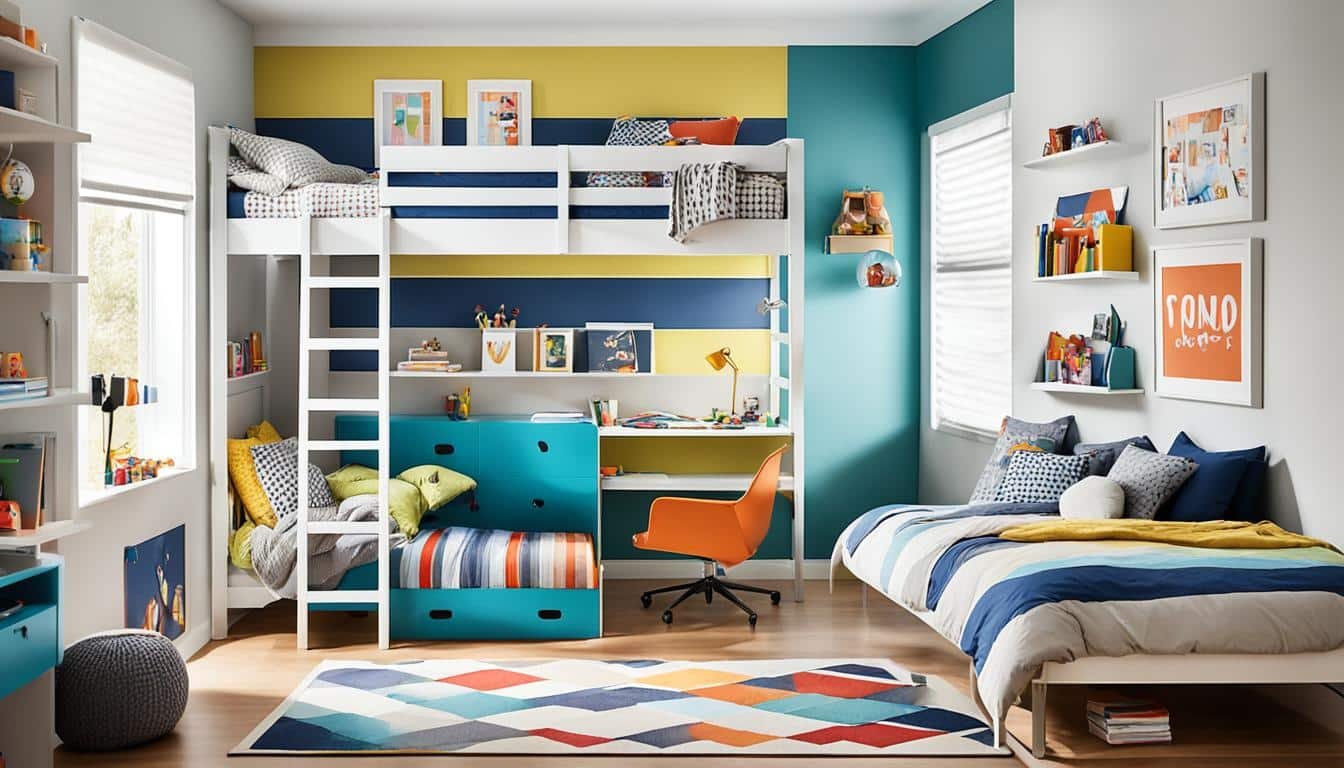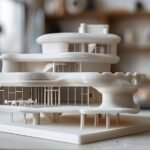Designing a kids’ room is an exciting opportunity to create a space that sparks imagination, fosters creativity, and provides functionality. Whether you’re revamping the existing bedroom or starting from scratch, incorporating playful themes, multifunctional furniture, and smart storage solutions can help you design a room that both you and your child will love.
When it comes to kids room design, there are endless possibilities to explore. From whimsical fantasies to real-life adventures, the theme you choose can set the stage for a truly enchanting space. Incorporating elements such as world map wall art, vintage suitcases for storage, and travel-themed decor can create an exploration-themed nursery that ignites a sense of curiosity and wanderlust.
But it’s not just about the aesthetics. Practicality is key when it comes to kids’ bedrooms. Furniture selection plays a crucial role in creating a functional space. Consider essential pieces like bunk beds for shared rooms, desks for studying, wardrobes and bookshelves for storage, and toy storage solutions to keep the room organized. Opting for multi-functional furniture, such as platform beds with built-in storage or ottomans that double as seating and storage, can maximize space and functionality.
Decorative accents add the finishing touch to a well-designed kids’ room. Rugs define the space and add warmth, curtains provide privacy and control natural light, lamps offer both functionality and ambiance, and pillows and cushions bring pops of color and comfort. Wallpapers and carpets can add visual interest and texture, and creative use of bedding and accents can create a vibrant and inviting atmosphere.
Storage is a vital aspect of any kids’ room. Explore options like drawers, baskets, bins, and toy chests to keep toys, clothes, and belongings neatly organized. Consider utilizing trundles and built-in storage solutions to maximize floor space, and take advantage of floating shelves and floor-to-ceiling storage units to maximize storage capacity.
Designing a shared kids’ room requires careful planning to ensure each child has their own space while maintaining a cohesive design. Visual dividers like curtains or room dividers offer privacy, and creative furniture arrangements can help maximize floor space. Additionally, creating a separate playroom within the shared space can keep the sleeping area clutter-free.
When designing kids’ rooms, it’s important to create a playful and functional space that encourages playtime and imagination. Incorporating designated play areas, accessible storage solutions, and easy-to-clean surfaces can contribute to a room that is both fun and practical, allowing your child’s creativity to flourish.
As children grow older, their interests evolve. Designing a room that can adapt to these changes is essential. Choose furniture and decor that can be easily updated or repurposed, and consider creating designated areas for different activities, such as reading, playing, and studying.
Themes and imaginative elements can truly bring a kids’ room to life. Encourage your child’s imagination by incorporating their favorite themes, whether it’s outer space, princesses, superheroes, or animals. Use wall decals, artwork, and bedding to create a space that reflects their wildest dreams and sparks endless creativity.
Lastly, adequate storage and organization solutions are crucial for maintaining a clutter-free and functional space. Utilize various storage options such as bins, baskets, organizers, and built-in shelving units to keep toys, books, and clothes in order. Involving your child in the organization process can instill good habits and a sense of responsibility.
Key Takeaways:
- Designing a kids’ room requires a balance between functionality and creativity.
- Incorporating playful themes, multifunctional furniture, and smart storage solutions can enhance the overall design.
- Consider the child’s interests, age, and available space when choosing furniture, decor, and storage options.
- Encourage imagination and creativity through imaginative elements and personalized touches.
- Create a clutter-free and organized space by utilizing various storage solutions.
Choosing the Right Furniture for Kids Room Design
When designing a kids’ room, it’s important to choose furniture that is both functional and appealing. The furniture you select should cater to your child’s needs, provide ample storage solutions, and contribute to the overall aesthetic of the room. Here are some essential pieces of furniture to consider:
Bunk Bed
A bunk bed is a great option for shared rooms as it maximizes floor space. It allows siblings or friends to sleep comfortably in the same room while creating a fun and adventurous atmosphere. Consider a bunk bed with built-in storage drawers or a trundle bed for additional functionality.
Desk for Studying
A desk provides a dedicated space for your child to study, do homework, or engage in creative activities. Choose a desk with ample surface area, drawers, and shelves for organizing school supplies and books. This will encourage productivity and help your child develop good study habits.
Wardrobe and Bookshelf for Storage
A wardrobe and bookshelf are essential for storing your child’s clothes, toys, and books. Look for a wardrobe with hanging space, shelves, and drawers to accommodate different types of clothing and accessories. A bookshelf with adjustable shelves can adapt to your child’s growing collection of books and toys.
Toy Storage Solutions
Keeping toys organized is crucial for maintaining a clutter-free space. Incorporate toy storage solutions such as bins, baskets, or toy chests. These can be placed on shelves, under the bed, or in designated play areas. Consider using labels or color-coding systems to make it easier for your child to find and put away their toys.
Multi-functional Furniture
Make the most of the available space in your child’s room by choosing multi-functional furniture. Platform beds with built-in storage drawers underneath provide a convenient solution for storing extra bedding, clothing, or toys. Opt for nightstands with extra drawers for additional storage and consider ottomans that can serve as seating and provide extra storage space.
Floor Cushions for Versatile Seating
Add floor cushions to create a cozy and versatile seating area in your child’s room. They can be used for reading, playing games, or relaxing. Floor cushions not only provide comfort but also add a touch of color and playfulness to the room.
“Choosing the right furniture for your child’s room is a crucial step in creating a space that is both functional and visually appealing. By considering the needs of your child and incorporating multi-functional furniture and ample storage solutions, you can design a room that grows with them and fosters a sense of organization and creativity.”
The right furniture choices can significantly impact the functionality and aesthetic of your child’s room. By considering the bunk bed, desk, wardrobe, bookshelf, toy storage, dresser, platform bed, multi-functional furniture, nightstand, ottoman, and floor cushions, you can create a well-designed and organized space that caters to your child’s needs and fosters their growth and development.
Adding Decorative Accents to Kids Room Design
Decorative accents play a crucial role in enhancing the overall aesthetic of a kids’ room. By carefully selecting the right accents, you can create a vibrant and inviting space that sparks creativity and joy. Here are some key decorative elements to consider when designing your child’s room:
1. Rugs
A rug not only adds warmth and comfort to the room but also defines the space. Choose a rug that complements the color scheme and theme of the room. Opt for colorful rugs with playful patterns or character designs to create a lively atmosphere.
2. Curtains
Curtains not only provide privacy but also control natural light. Select curtains in vibrant colors or patterns that match the overall theme of the room. Consider blackout curtains to ensure a dark and peaceful environment during restful hours.
3. Lamps
Lamps serve both functional and decorative purposes in a kids’ room. Choose lamps that add a touch of whimsy and charm, such as ones in the shape of animals or unique designs. Use them as accent pieces and sources of soft, ambient lighting.
4. Pillows and Cushions
Pillows and cushions can inject pops of color and comfort into the room. Select pillows with playful designs or patterns that complement the overall theme. Mix and match different sizes and textures to create a cozy and inviting space for your child to relax and play.
5. Wallpaper and Carpets
Wallpaper and carpets can add visual interest and texture to the room. Consider wallpaper with colorful patterns or themed designs to make a statement wall. Choose carpets that are soft and durable, providing a comfortable surface for playtime activities.
Don’t be afraid to use bold accents and colorful accessories to create an inviting and stimulating environment that reflects your child’s personality. Remember, the key is to strike a balance between functionality and aesthetics, creating a space where your child can thrive and let their imagination run wild.
| Decorative Accent | Description |
|---|---|
| Rug | Defines the space and adds warmth |
| Curtains | Provide privacy and control natural light |
| Lamp | Serves as both a functional and decorative lighting source |
| Pillows and Cushions | Brings pops of color and comfort |
| Wallpaper and Carpets | Add visual interest and texture |
With these decorative accents, you can transform your child’s room into a vibrant and imaginative space that they will love spending time in.
Maximizing Storage Space in Kids Room Design

Effective storage solutions are essential for keeping a kids’ room organized. To create a clutter-free space that promotes easy tidying and a tidy environment, it is important to incorporate various storage options. By utilizing a combination of drawers, baskets, bins, and toy chests, toys, clothes, and other belongings can be easily stored and accessed.
Maximizing floor space is crucial in a kids’ room, especially if the room is small. Consider investing in trundle beds and bunk beds with built-in storage. These beds not only provide a comfortable sleeping space but also offer additional storage options, such as drawers or shelves, underneath the bed. This space-saving feature allows for efficient use of the floor area without compromising on storage capacity.
When floor space is limited, it is worth considering floating shelves and built-in storage units. These storage solutions can be mounted on the walls, providing valuable storage space for books, toys, and decorative items. The vertical placement of these shelves and units ensures that the floor area remains clear and open, creating a visually spacious room.
To fully optimize storage capacity in a kids’ room, floor-to-ceiling storage units are highly recommended. These units run from the floor to the ceiling, utilizing every inch of available vertical space. With multiple shelves and compartments, they offer ample storage for various items, including clothes, toys, and books. Floor-to-ceiling storage units also provide a visually appealing and organized look to the room.
All of these storage solutions contribute to a well-organized and tidy kids’ room. By incorporating drawers, baskets, bins, and toy chests, along with trundle beds, floating shelves, built-in storage units, and floor-to-ceiling storage, parents can create a functional and clutter-free space for their children to enjoy.
| Storage Solution | Description |
|---|---|
| Drawers | Easy-access storage for clothes and small items. |
| Baskets | Flexible storage options for toys and other belongings. |
| Bins | Organized storage for larger toys and bulky items. |
| Toy Chests | A fun and functional storage solution for toys. |
| Trundle Beds | Maximize floor space with built-in storage underneath. |
| Floating Shelves | Wall-mounted storage for books, toys, and decor. |
| Built-in Storage Units | Creative storage options that blend seamlessly into the room. |
| Floor-to-Ceiling Storage | Utilize vertical space for maximum storage capacity. |
Table: Various storage solutions for maximizing storage space in a kids’ room.
Designing Shared Kids Room
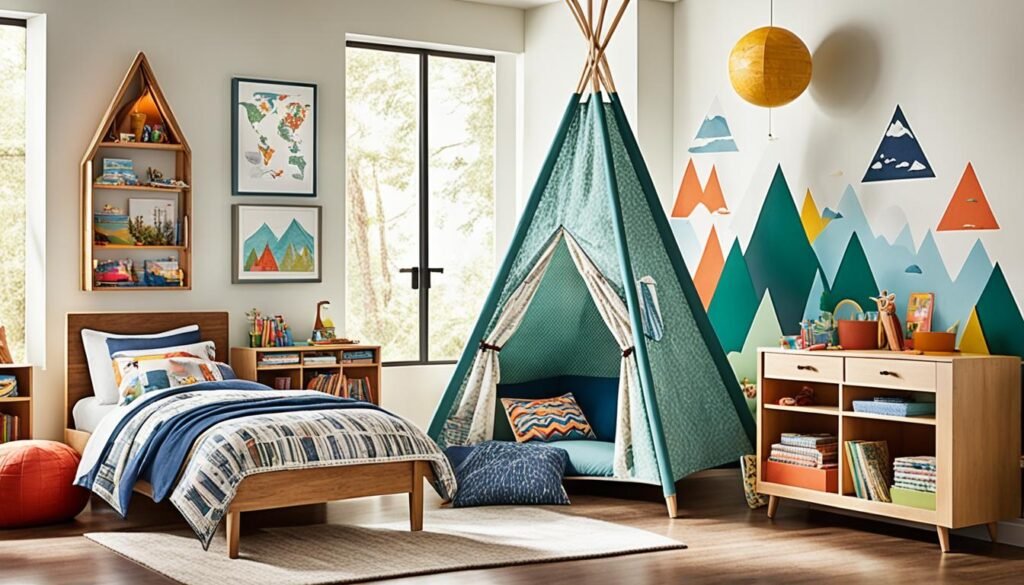
Designing a shared kids’ room requires careful planning to ensure that each child has their own space while still maintaining a cohesive design. It’s important to create a harmonious environment that allows both children to express their individuality while fostering a sense of togetherness.
One effective way to visually divide the room is by using curtains or room dividers. This allows each child to have their own defined area while still sharing the same physical space. The curtains can be chosen in colors or patterns that reflect each child’s personality and preferences.
It’s also essential to provide each child with their own designated area for personal belongings and decor. This can be achieved by using separate storage units or shelves for each child. These areas can be customized with their names, photos, or favorite decorations to make them feel special.
To maximize floor space in a shared room, it’s important to incorporate multi-functional furniture and storage solutions. Bunk beds or loft beds with built-in storage drawers can provide a comfortable sleeping space while also offering additional storage for clothes and belongings. Consider using beds with trundles for extra sleeping arrangements that can be tucked away during the day.
Creating a separate playroom within the shared room can help keep the sleeping area clutter-free and provide a dedicated space for play and creativity. Use colorful storage bins and shelves to neatly organize toys and games. Consider incorporating a play table or reading nook to encourage imaginative play and quiet time.
Designing a shared kids’ room requires finding the right balance between individuality and unity. By dividing the room visually, providing each child with their own space, and maximizing floor space, you can create a functional and harmonious environment for both children to enjoy.
Remember, shared bedroom ideas should focus on creating a space that allows each child to express themselves while fostering a sense of cooperation and respect. With the right design choices and storage solutions, a shared kids’ room can become a place where lifelong memories are made.
| Shared Kids Room Design Tips | Benefits |
|---|---|
| Create a visual division with curtains or room dividers | Allows each child to have their own defined space |
| Provide each child with their own designated area for personal belongings and decor | Gives a sense of ownership and individuality |
| Incorporate multi-functional furniture with built-in storage | Maximizes floor space and provides ample storage |
| Create a separate playroom within the shared room | Keeps the sleeping area organized and provides a dedicated play space |
Creating a Playful and Functional Space in Kids Room Design
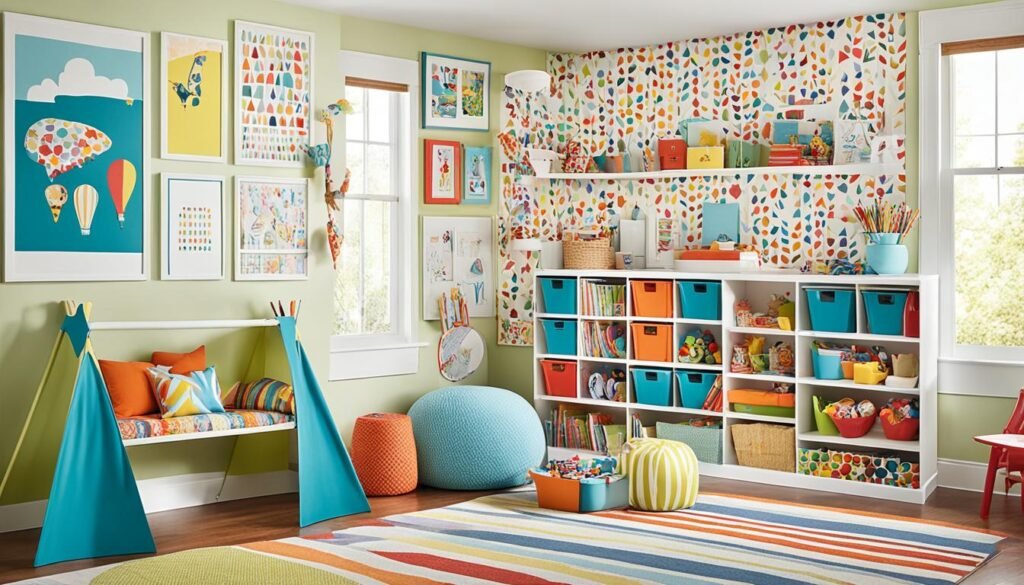
Kids’ rooms should be both playful and functional, providing a space where children can explore, play, and learn. To achieve this, it’s important to consider different elements of design that enhance both playtime and organization. By incorporating interactive room layouts and space-saving storage solutions, you can create a room that promotes creativity and keeps toys and clothes easily accessible.
To start, consider creating a designated play area within the room, separated from the sleeping area. This can be achieved by using colorful rugs or floor cushions to define the space. In this playroom area, incorporate interactive elements such as a play kitchen, a reading nook, or a craft corner. These additions encourage imaginative play and provide opportunities for children to engage in hands-on activities.
When it comes to storage, prioritize functionality and accessibility. Wall-mounted storage units, hanging organizers, and creative shelving can help maximize space and make it easier to keep toys and clothes organized. Utilize clear bins or baskets to store and categorize different types of toys, making it easier for children to find and put away their belongings. Incorporating labels or picture labels can also assist younger children in identifying where items belong.
Remember to design the room with easy clean-up and organization in mind. Consider using toy chests, storage ottomans, or floor-to-ceiling shelves to keep the space tidy. Make sure the room layout allows for ample space to move around and play freely. This will make playtime more enjoyable and also provide a safe environment for children to explore.
In conclusion, by creating a playful and functional space in a kids’ room, you can foster their imagination, creativity, and independence. By incorporating interactive room layouts, space-saving storage solutions, and a thoughtful organization system, you can design a room that is both visually appealing and practical.
Designing Kids Room for Different Ages
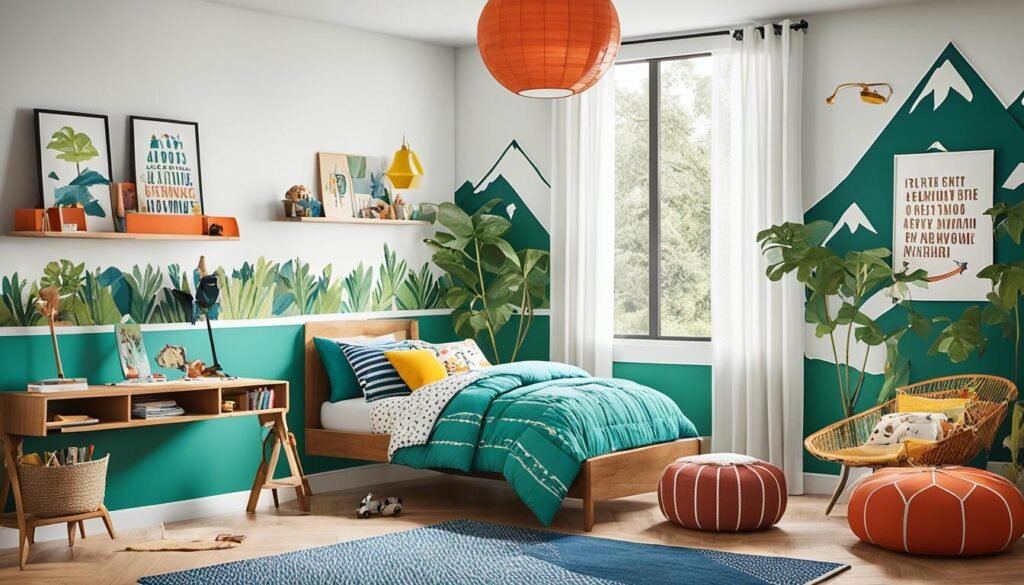
Kids’ room design should be flexible enough to accommodate different ages and changing interests. As children grow older, their needs and preferences evolve, making it important to create a space that can be easily updated or repurposed.
When selecting furniture, opt for versatile pieces that can adapt to various stages of childhood. For example, choose a crib that can be converted into a toddler bed or a twin bed as your child gets older. This allows the room to grow with them and saves you the hassle of purchasing new furniture.
It is also essential to consider the interests and tastes of your child as they get older. Bright and colorful accents may appeal to younger children, while older kids may prefer more sophisticated and smartly designed elements. Incorporate decor that can be easily swapped out or updated over time to reflect their ever-changing interests.
Furthermore, creating designated areas within the room can cater to different activities and stages of development. Include a cozy reading nook with a bookshelf for younger children, and as they get older, transform the space into a study area with a desk and task lighting.
By designing a kids’ room to accommodate different ages, you can create a space that not only meets the current needs of your child but also adapts to their growth and development over time.
Designing for Different Age Groups
Here are some tips for designing a kids’ room that caters to different age groups:
- Choose furniture that can be easily adjusted or repurposed as your child grows older.
- Incorporate versatile storage solutions that can adapt to changing needs.
- Consider using neutral or timeless colors as a base and adding pops of color with easily replaceable accents.
- Create designated areas within the room for sleeping, studying, playing, and relaxing.
Designing a kids’ room for different ages requires thoughtful planning to ensure the space remains functional and appealing as children grow older. By considering their evolving interests and needs, you can create a room that can adapt and grow with them.
Incorporating Themes and Imaginative Elements in Kids Room Design

Themes and imaginative elements can truly bring a kids’ room to life. By incorporating outer space, princesses, superheroes, or animals based on your child’s interests, you can create a space that reflects their wildest imagination. Use wall decals, artwork, and bedding to transform the room into a captivating and imaginative environment.
To encourage imaginative play, consider creating a cozy reading nook or a dedicated corner for your child to explore their creative ideas. This adventure playroom will serve as a space where their imagination can soar beyond the limits of reality. It’s important to allow your child to contribute their ideas and creativity to make their room a true reflection of their personality and interests.
Imagination is more important than knowledge. For knowledge is limited, whereas imagination embraces the entire world,
stimulating progress, giving birth to evolution.
As parents, providing a creative space for kids to explore their imagination is essential. Incorporating themes and imaginative elements not only enhances the aesthetics of the room but also nurtures your child’s growth and development. It fosters a sense of wonder, curiosity, and opens doors to endless possibilities.
Creating an Outer Space Adventure
One of the most popular themes for kids’ rooms is outer space. With its vast expanse and endless mysteries, outer space captivates the imaginations of children. To create an outer space adventure playroom, you can use a combination of celestial wall decals, glow-in-the-dark stars, and a themed bedspread. Hang a mobile featuring planets and astronauts above the crib or bed to spark curiosity and exploration.
| Key Elements | Imaginative Enhancements |
|---|---|
| Celestial Wall Decals | Transform the walls into a starry night sky. |
| Glow-in-the-Dark Stars | Add a touch of magic and wonder to the room. |
| Themed Bedspread | Immerse your child in a cosmic dream. |
| Planet Mobile | Encourage fascination with the solar system. |
By creating an outer space adventure-themed room, you’ll ignite your child’s imagination and nurture their curiosity about the universe. It’s a perfect way to create a space where every bedtime becomes a celestial journey and every waking moment is filled with awe and wonder.
Maximizing Storage and Organization in Kids Room Design
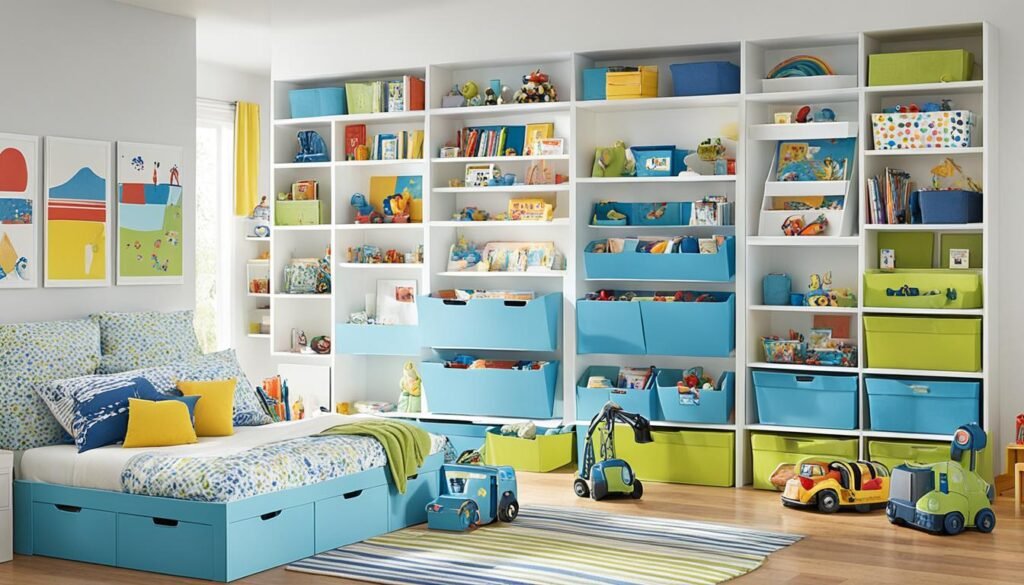
Adequate storage and organization solutions are crucial for creating a tidy and functional kids’ room. With the right strategies, you can save space and ensure there is plenty of storage for all your children’s belongings. In addition to keeping the room clutter-free, effective storage solutions also contribute to the overall aesthetic of the children’s bedroom decor. Take a look at some smart storage solutions and nursery interior ideas that will help you achieve an organized and visually appealing space.
Utilize Bins, Baskets, and Organizers
One of the simplest yet effective ways to organize a kids’ room is to use bins, baskets, and organizers. These versatile storage solutions come in various sizes, shapes, and designs, making it easy to find options that complement the room’s style. Use them to keep toys, books, and clothes in their designated places, minimizing clutter and creating a more spacious environment. By assigning a specific bin or basket for different categories of items, you can encourage your children to maintain order and develop good organizational habits.
Consider Built-in Storage Options
Incorporating built-in storage options is an excellent way to optimize space in a kids’ room. Consider installing shelving units, closet systems, or even customized under-bed storage solutions. These built-in options provide ample storage while seamlessly blending with the room’s decor. They not only help save space but also create a streamlined and cohesive look. By utilizing every nook and cranny of the room, you can maximize storage capacity and ensure that everything has its place.
Make Use of Wall Space
When it comes to storage, don’t overlook the potential of wall space. Hooks and hanging organizers can be a practical and visually pleasing addition to any kids’ room. Hang hooks on the walls for coats, backpacks, or hats, keeping them easily accessible and off the floor. Hanging organizers, such as fabric pockets or canvas shoe holders, can store smaller items like art supplies, small toys, or accessories. By utilizing vertical storage solutions, you not only save valuable floor space but also add an interesting visual element to the room.
Encourage Your Child’s Participation
Getting your child involved in the organization process can be beneficial for creating a functional and tidy space. Encourage them to contribute to the selection of storage solutions and allow them to have a say in how their belongings are organized. By giving them a sense of ownership and responsibility, they will be more inclined to maintain order and take pride in their organized room. Teaching your child the importance of storage solutions and maintaining an organized space sets the foundation for good habits that will extend beyond their childhood years.
| Storage Solution | Description |
|---|---|
| Bins and Baskets | These versatile storage options are perfect for organizing toys, books, and clothes. Available in various sizes, shapes, and designs. |
| Built-in Shelving Units | Maximize space and create a streamlined look by incorporating built-in shelving units. Perfect for displaying toys, books, and decorative items. |
| Hooks and Hanging Organizers | Utilize wall space with hooks and hanging organizers for coats, bags, and smaller items. Adds a decorative and functional element to the room. |
| Under-Bed Storage | Make the most of the space under the bed by utilizing customized storage solutions. Perfect for storing seasonal items, extra bedding, or shoes. |
By implementing these storage solutions and nursery interior ideas, you can create a clutter-free and organized kids’ room that not only saves space but also complements the overall decor. Remember to involve your child in the process to instill good organizational habits from a young age. With plenty of storage and a well-organized space, your children will have a functional and inviting room to play, sleep, and grow.
Designing a Kids Room on a Budget

Designing a kids’ room doesn’t have to break the bank. With a little creativity and resourcefulness, you can create a playful and stylish space for your little one without spending a fortune.
One budget-friendly option is to embrace DIY projects. Get crafty and repurpose old furniture or accessories to give them new life. Transform an old dresser into a colorful, kid-friendly storage solution, or paint a plain nightstand with bright, playful colors.
Another great way to save money is to shop at thrift stores or explore online marketplaces. You’ll be amazed at the treasures you can find at affordable prices. Consider browsing through vintage stores or consignment shops for unique decor items that add character to the room.
Playful room design can be achieved through clever use of colors, patterns, and accessories. Opt for vibrant bedding, curtains, and rugs to create an energetic atmosphere. Add pops of color with accent pillows or fun wall decals that can be easily removed or changed as your child’s interests evolve.
When it comes to storage, think beyond traditional options. Invest in fabric storage bins that are both affordable and functional. They come in various sizes and designs, making it easy to keep toys, books, and clothes organized. Take advantage of wall space by installing floating shelves where your child can display their favorite toys or books.
For affordable art options, consider printing out your favorite images or illustrations and framing them. Websites like Etsy offer a wide range of printable art at reasonable prices. You can also encourage your child’s creativity by showcasing their artwork in simple frames or hanging a clothesline where they can proudly display their masterpieces.
Key Takeaways:
- Save money by embracing DIY projects and repurposing old furniture or accessories.
- Explore thrift stores and online marketplaces for affordable decor and furniture options.
- Create a playful room design using vibrant colors, patterns, and removable accessories.
- Utilize fabric storage bins and floating shelves for affordable and functional storage solutions.
- Print out affordable art or showcase your child’s artwork to add a personal touch to the room.
Designing a kids’ room on a budget is all about getting creative and thinking outside the box. By following these tips, you can create a beautiful and fun space for your child without breaking the bank.
Also Read: Cambridge Architecture: Historic Charm And Design
Conclusion
Designing a kids’ room is an exciting endeavor that requires careful consideration of both functionality and playfulness. By taking into account the child’s interests, age, and available space, you can create a room that sparks imagination and provides ample storage. Incorporating themes and imaginative elements personalized to your child’s taste adds a unique touch to the overall design.
A well-designed kids’ room not only enhances the functionality and comfort of the space but also fosters creativity and playfulness. By choosing the right furniture, decor, and storage solutions, you can create a room that not only meets the child’s needs but also promotes their growth and development. Remember, a functional and playful space is the key to designing a kids’ room that they will love and enjoy for years to come.
When designing a kids’ room, it’s essential to strike a balance between practicality and fun. Consider multifunctional furniture, smart storage solutions, and a layout that encourages play and imagination. By creating a space tailored to your child’s needs, you’re setting the stage for a room that supports their development and nurtures their creativity. With the right design elements and thoughtful planning, you can transform a kids’ room into a functional and playful haven.
FAQs
Q: What are some kids bedroom design themes to consider?
A: Some popular kids bedroom design themes include minimalist, brightly colored, smartly designed, and multifunctional spaces.
Q: How can I decorate a shared bedroom for kids?
A: To decorate a shared bedroom for kids, consider creating separate areas within the room using different colors or furniture arrangements to give each child their own space.
Q: What design ideas can help maximize space in a kids’ bedroom?
A: Utilize vertical space with floor-to-ceiling storage, consider multifunctional furniture like a loft bed with a desk underneath, and use clever storage solutions like toy chests and drawer organizers.
Q: How can I incorporate my child’s interests into their room design?
A: You can incorporate your child’s interests into their room design by adding themed decor, such as posters, bedding, or wall decals related to their favorite hobbies, sports, or characters.
Q: What are some simple and effective ways to update a kids’ bedroom design as they grow older?
A: Opt for versatile furniture pieces that can adapt to changing needs, use neutral colors for a timeless look, and involve your child in the design process to create a space that reflects their personality as they get older.
Q: How can I make a small kids’ bedroom feel more spacious?
A: To make a small kids’ bedroom feel more spacious, use light and bright colors, opt for furniture with hidden storage, and keep the room clutter-free by organizing toys and clothes in designated spaces.
Q: What are some unique design tips for creating a functional and stylish kids’ bedroom?
A: Consider adding a window seat for reading nooks, creating a gallery wall to display artwork, incorporating a play area or a designated space for hobbies, and using rugs and pillows to add warmth and comfort to the room.
